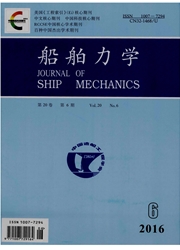

 中文摘要:
中文摘要:
超髙强度钢EH47广泛应用于超大型集装箱船舱口围板等区域结构中, 建造过程中常常伴随着较大的焊 接残余应力, 直接影响到船体结构的安全及使用寿命.论文基于有限元分析软件ANSYS, 对平板对接焊进行模 拟, 得到焊接残余应力的大小和分布, 并采用盲孔法对焊缝区域进行残余应力测量.结果表明: 残余应力在靠近 焊缝中心及区域附近处表现为拉应力, 随着逐渐往焊缝中心靠拢, 拉应力迅速增大, 当达到焊缝中心附近时拉应 力达到最大值.随着逐渐远离焊缝中心, 拉应力迅速减小, 达到一定距离时转变为压应力, 并在距离焊趾2.5 cm 处达到压应力最大值, 数值模拟结果与试验测量值基本吻合, 同时焊后热处理能有效降低有损结构强度的焊接 残余应力.
 英文摘要:
英文摘要:
EH47 ultra-high-strength steel is widely used in regional structures of ultra large container hatch hoardings, the construction process is often accompanied by high welding residual stress which directly af-fects the security and life of the hull structure. The thesis based on finite element analysis software ANSYS, simulated for flat butt welding and obtained the size and distribution of welding residual stress, and used blind hole method for the weld area residual stress measurement. The results show that residual stresses near the weld area and the center showed tensile stress, with the gradual approach to the weld center, the ten-sile stress increases rapidly, when it reaches near the center of the weld, tensile stress reaches a maximum. With moving away from the center of the weld, the tensile stress decreases rapidly, up to a certain distance changes into compressive stress and compressive stress reaches a maximum at a distance of 2.5 centimeter at the weld toe, the simulation results are consistent with the experiment measured values, and heat treatment after welding can effectively reduce detrimental to the structural strength of the welding residual stresses.
 同期刊论文项目
同期刊论文项目
 同项目期刊论文
同项目期刊论文
 期刊信息
期刊信息
